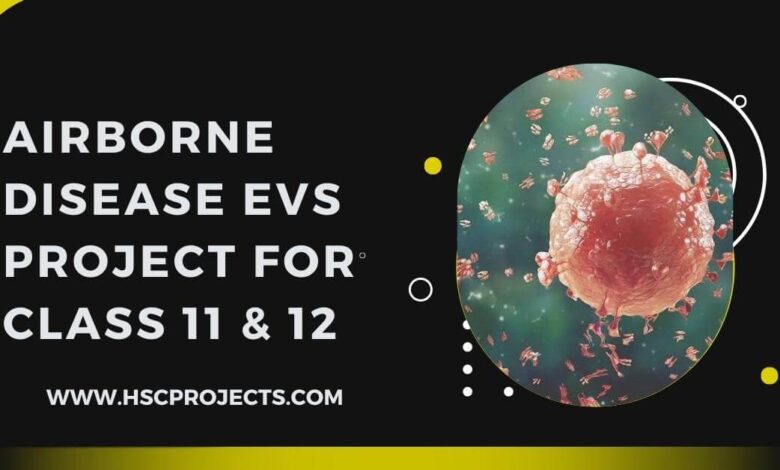
Airborne Disease Evs Project For Class 11 & 12
Acknowledgment:
I would like to express my sincere gratitude to all those who have contributed to the successful completion of this AIRBORNE DISEASE EVS project for class 11 and 12.
First and foremost, I am deeply thankful to my Environmental Science (EVS) teacher for providing me with the opportunity to explore this important topic. Their guidance, encouragement, and valuable feedback have been instrumental in shaping this project.
I would also like to extend my thanks to my parents and family for their constant support and understanding throughout the project’s duration. Their encouragement and belief in my abilities have been a constant source of motivation.
Furthermore, I want to acknowledge the valuable resources and references that I have utilized while researching and gathering information for this project. The books, scientific journals, online articles, and reputable websites have been invaluable sources of knowledge.
I also want to thank my friends and classmates for their valuable discussions and inputs, which have helped me broaden my perspective on airborne diseases and their impact on public health.
Thank you all for your support and contributions. This project would not have been possible without each one of you.
Introduction :
In the realm of public health and environmental science, understanding the transmission and impact of infectious diseases is of paramount importance. Airborne diseases, a subset of infectious illnesses, present unique challenges due to their ability to spread through the air we breathe. These diseases, caused by microorganisms such as viruses, bacteria, or fungi, can be transmitted from person to person through respiratory droplets or small airborne particles when an infected individual coughs, sneezes, talks, or exhales.
The purpose of this Environmental Science (EVS) project is to delve into the world of airborne diseases, exploring their modes of transmission, prevention, and the impact they have on global health. The project aims to raise awareness about these diseases and highlight the significance of taking preventive measures to combat their spread.
In this project, we will delve into the key aspects of airborne diseases, starting with an overview of how these infections are transmitted and their differentiation from other forms of diseases. We will discuss the modes of transmission, focusing on the role of respiratory droplets and airborne particles in propagating these infections.
Furthermore, the project will delve into preventive measures and control strategies to mitigate the spread of airborne diseases. We will explore the importance of personal hygiene, proper ventilation, isolation and quarantine protocols, vaccination, and the use of masks as effective preventive measures.
To provide a comprehensive understanding, the project will also examine some of the most common examples of airborne diseases. From the seasonal flu and tuberculosis to more recent global challenges like COVID-19, each of these diseases has had significant impacts on public health and serves as a reminder of the importance of preparedness and proactive measures.
Through this EVS project, we hope to enhance the knowledge and awareness of airborne diseases among our peers, teachers, and the wider community. By understanding the transmission mechanisms and adopting preventive strategies, we can collectively work towards creating a healthier and safer environment for everyone.
Let us embark on this journey to unravel the intricacies of airborne diseases and gain insights that can contribute to better public health practices and disease prevention.

Modes of Transmission :
Airborne diseases are primarily transmitted through respiratory droplets or small airborne particles that contain infectious microorganisms. Let’s explore the two main modes of transmission:
- Droplet Transmission:
Droplet transmission occurs when an infected person coughs, sneezes, talks, or even breathes, releasing larger respiratory droplets into the air. These droplets typically range in size from 5 to 10 micrometers and can contain a significant amount of infectious agents. They travel relatively short distances (usually within 3 feet) and can infect individuals who come into direct contact with these droplets. This mode of transmission is a common way for airborne diseases to spread, especially in close-contact settings like households, schools, or healthcare facilities. - Airborne Transmission:
Airborne transmission involves the dissemination of smaller airborne particles containing infectious agents, which are much smaller than respiratory droplets (less than 5 micrometers in size). These tiny particles can remain suspended in the air for extended periods, sometimes hours, and can travel longer distances, even beyond 3 feet. Unlike droplet transmission, airborne transmission allows pathogens to infect individuals who are farther away from the infected source. This mode of transmission poses a higher risk in poorly ventilated spaces and can result in widespread outbreaks, particularly in crowded or enclosed environments.
It is essential to understand that some diseases can exhibit both modes of transmission, and the relative importance of each mode can vary depending on the specific disease and its characteristics. For instance, diseases like COVID-19 and tuberculosis can spread through both droplet and airborne routes, making them particularly challenging to control and contain.
Prevention and Control:
Preventive measures such as wearing masks, practicing proper respiratory hygiene, maintaining physical distance, and ensuring adequate ventilation in indoor spaces play a crucial role in reducing the transmission of airborne diseases. Public health authorities and healthcare professionals continually emphasize the importance of these preventive strategies to mitigate the spread of infectious agents and protect individuals and communities from airborne diseases.
Prevention and control strategies for airborne diseases are crucial to safeguard public health and minimize the spread of infectious agents. Implementing these measures can help reduce the transmission of airborne diseases and protect individuals and communities from outbreaks. Here are some essential prevention and control measures:
- Personal Hygiene and Respiratory Etiquette:
Encourage frequent handwashing with soap and water for at least 20 seconds, especially after coughing, sneezing, or being in public places.
Cover the mouth and nose with a tissue or the elbow when coughing or sneezing to prevent the release of respiratory droplets into the air.
Avoid touching the face, especially the eyes, nose, and mouth, as this can transfer infectious agents from contaminated surfaces.
- Wear Masks:
The use of masks, particularly when physical distancing is challenging, can help prevent the spread of respiratory droplets and airborne particles containing infectious agents.
Masks, such as surgical masks or well-fitted cloth masks, can protect both the wearer and others around them.
- Maintain Physical Distancing:
Practice physical distancing by staying at least 3 feet away from others, especially from those who show symptoms of respiratory illness.
In settings where airborne transmission is a concern, increasing the distance between individuals can reduce the risk of infection.
- Ventilation and Air Quality:
Ensure proper ventilation in indoor spaces to reduce the concentration of infectious particles in the air.
Open windows and use mechanical ventilation systems to improve air circulation and replace indoor air with fresh outdoor air.
- Isolation and Quarantine:
Infected individuals should be isolated from others to prevent the spread of the disease.
Close contacts of infected individuals should be quarantined to monitor for symptoms and prevent further transmission.
- Vaccination:
Vaccines play a crucial role in preventing airborne diseases. They can provide immunity against specific pathogens, reducing the severity of infections and preventing outbreaks.
Encourage vaccination campaigns to increase the percentage of vaccinated individuals within a community, creating herd immunity and protecting vulnerable populations.
- Public Health Awareness:
Educate the public about the importance of preventive measures and the signs and symptoms of airborne diseases.
Raise awareness about disease transmission and encourage early detection and reporting of cases.
- Environmental Cleaning and Disinfection:
Regularly clean and disinfect frequently touched surfaces and objects, such as doorknobs, handles, and shared equipment, to minimize the risk of contamination.
- Travel Restrictions and Border Control:
During outbreaks, implementing travel restrictions and border control measures can help prevent the introduction and spread of airborne diseases across regions and countries.
It is essential to note that the effectiveness of these prevention and control strategies depends on widespread adherence and cooperation from individuals, communities, and governments. Combining multiple measures can create a comprehensive approach to tackling airborne diseases and protecting public health. Public health authorities, healthcare professionals, and policymakers play a vital role in implementing and promoting these strategies to mitigate the impact of airborne diseases on global health.
Examples of Airborne Diseases:
Airborne diseases encompass a wide range of infectious illnesses caused by various microorganisms. Here are some common examples of airborne diseases:
- Influenza (Flu):
Influenza is a highly contagious viral infection that primarily affects the respiratory system.
The virus spreads through respiratory droplets when an infected person coughs, sneezes, or talks.
Symptoms include fever, cough, sore throat, body aches, fatigue, and sometimes respiratory distress.
- Tuberculosis (TB):
Tuberculosis is a bacterial infection caused by Mycobacterium tuberculosis.
The bacteria can spread through airborne particles when an infected person with active TB coughs or sneezes.
TB primarily affects the lungs but can also affect other organs.
Symptoms include persistent cough, chest pain, weight loss, fever, and night sweats.
- COVID-19:
COVID-19 is caused by the SARS-CoV-2 virus and emerged as a global pandemic in 2019-2020.
The virus spreads primarily through respiratory droplets, but it can also be transmitted through airborne particles in certain settings.
Common symptoms include fever, cough, shortness of breath, loss of taste or smell, and fatigue.
- Measles:
Measles is a highly contagious viral disease caused by the measles virus.
The virus spreads through respiratory droplets and can remain in the air for several hours after an infected person has left the area.
Symptoms include high fever, cough, runny nose, red eyes, and a characteristic rash.
- Chickenpox (Varicella):
Chickenpox is a viral infection caused by the varicella-zoster virus.
The virus spreads through respiratory droplets and direct contact with skin lesions.
Symptoms include an itchy rash with red spots that later turn into fluid-filled blisters.
- Mumps:
Mumps is a viral infection caused by the mumps virus.
The virus spreads through respiratory droplets and contact with saliva from an infected person.
Symptoms include swelling and pain in the salivary glands, fever, headache, and muscle aches.
- Whooping Cough (Pertussis):
Pertussis is a bacterial infection caused by Bordetella pertussis.
The bacteria spread through respiratory droplets when an infected person coughs or sneezes.
Symptoms include severe coughing fits, “whooping” sound during inhalation, and vomiting.
- Severe Acute Respiratory Syndrome (SARS):
SARS is caused by the SARS coronavirus (SARS-CoV).
The virus spreads through respiratory droplets and can cause severe respiratory illness.
SARS was responsible for an outbreak in 2002-2003.
These are just a few examples of airborne diseases. Each of these diseases poses unique challenges to public health, and preventive measures are essential to control their transmission and impact on communities. Vaccination, early detection, and adherence to preventive strategies are crucial in combating these airborne diseases effectively.
Conclusion:
Airborne diseases present a significant threat to public health, as they can spread rapidly and affect large populations. Through this Environmental Science (EVS) project, we have explored the world of airborne diseases, understanding their modes of transmission, prevention, and impact on global health.
We learned that airborne diseases can be transmitted through respiratory droplets or small airborne particles containing infectious microorganisms. The modes of transmission, such as droplet and airborne, vary in distance and potential for widespread dissemination. Preventive measures play a critical role in controlling the spread of these diseases and protecting individuals and communities from infection.
By promoting personal hygiene and respiratory etiquette, such as frequent handwashing and proper coughing/sneezing practices, we can limit the release of infectious agents into the air. Wearing masks, maintaining physical distance, and ensuring proper ventilation are crucial in reducing the risk of exposure to airborne pathogens.
Isolation and quarantine protocols are essential in containing outbreaks, while vaccination remains one of the most effective tools in preventing airborne diseases. Creating public awareness about these diseases and their transmission is key to fostering a sense of responsibility and cooperation among individuals and communities.
Throughout this project, we have examined various examples of airborne diseases, including influenza, tuberculosis, COVID-19, measles, and others. Each of these diseases has had a profound impact on global health, underscoring the importance of preparedness and proactive measures to combat their spread.
In conclusion, combating airborne diseases requires a collective effort involving governments, healthcare organizations, communities, and individuals. By implementing the preventive and control strategies discussed in this project, we can work together to create a healthier and safer environment, reducing the burden of airborne diseases and protecting the well-being of people worldwide.
As we move forward, it is essential to stay informed, adapt to evolving challenges, and prioritize public health initiatives to safeguard ourselves and future generations from the threats posed by airborne diseases. Let this project serve as a reminder of the significance of our actions in shaping a healthier and resilient world.
Certificate:
[Your School/Institution Logo]Date: [Current Date]
Dear [Teacher’s Name],
I am excited to present my completed project on “Airborne Diseases: Causes, Prevention, and Impact on Public Health” for Class 11 and 12. This project has been an enlightening and informative endeavor, allowing me to explore the critical issue of airborne diseases and their implications on public health.
Throughout this project, I delved into the study of various airborne diseases, understanding their causes, transmission mechanisms, and impact on human health. I researched the pathogens responsible for these diseases, such as bacteria, viruses, and fungi, and how they can remain suspended in the air and be transmitted from person to person.
One of the central aspects of my research was to analyze the factors that contribute to the spread of airborne diseases. I investigated environmental factors, such as air pollution and climate change, which can influence the transmission and prevalence of these diseases. Additionally, I explored the role of human behavior and population density in disease transmission.
Furthermore, I examined the importance of public health measures in preventing and controlling airborne diseases. I researched the significance of vaccination, quarantine protocols, and public awareness campaigns in reducing the risk of outbreaks and controlling the spread of these diseases.
To gain practical insights, I had the opportunity to interview medical professionals and experts in the field of infectious diseases. Their perspectives provided invaluable information about the challenges faced in tackling airborne diseases and the strategies employed to protect public health.
Moreover, I researched case studies of significant airborne disease outbreaks in the past, such as the SARS epidemic and COVID-19 pandemic, to understand the lessons learned and the importance of global collaboration in combating such health crises.
Completing this project has been an eye-opening experience, and it has deepened my understanding of the impact of airborne diseases on public health. I am eager to share the knowledge and insights gained from this project with my classmates and the wider community to promote awareness and understanding of preventive measures.
I am deeply grateful to my subject teacher, [Teacher’s Name], for their constant encouragement and guidance throughout this project. Their expertise and constructive feedback were instrumental in shaping my research and analysis, and I am thankful for their unwavering support.
I would also like to extend my gratitude to my parents/guardians for their continuous support and encouragement throughout this project. Their belief in my abilities motivated me to work diligently and strive for excellence in my research and presentation.
Additionally, I want to thank my classmates and friends for engaging in thoughtful discussions and providing valuable feedback. Their input has been instrumental in refining my understanding of the subject matter.
Moreover, I am thankful for the availability of various resources, including books, articles, online databases, and scientific journals. These resources were invaluable in gathering reliable information and providing a comprehensive overview of the topic.
Receiving this Certificate of Appreciation is an honor, and I am sincerely grateful for the opportunity to work on the “Airborne Diseases: Causes, Prevention, and Impact on Public Health” project. I hope that the research presented in this project contributes to a better understanding of the complexities surrounding airborne diseases and emphasizes the significance of proactive public health measures.
Once again, I extend my heartfelt thanks to everyone who supported and contributed to the successful completion of this project. Your encouragement and assistance have been invaluable, and I am deeply appreciative of your belief in my abilities.
Sincerely,
[Your Name]In order to download the PDF, You must follow on Youtube. Once done, Click on Submit
Follow On YoutubeSubscribed? Click on Confirm
Download Airborne Disease Evs Project For Class 11 & 12 PDF






